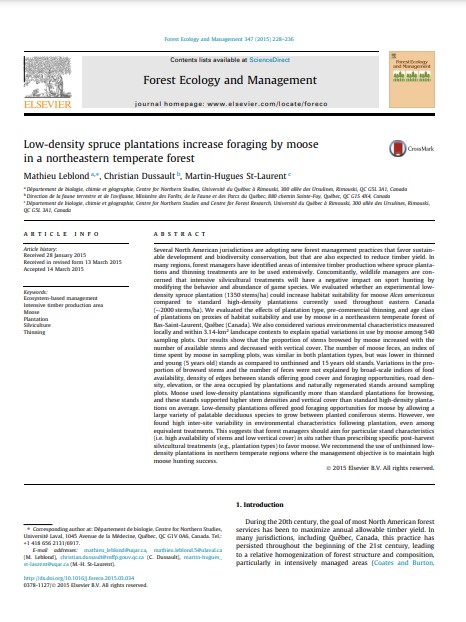Low-density spruce plantations increase foraging by moose in a northeastern temperate forest.
Bosque Modelo:
Bas-Saint-Laurent
Temática:
Gestión forestal
Tipo de documento:
Artículo científico
Resumen
Several North American jurisdictions are adopting new forest management practices that favor sustainable development and biodiversity conservation, but that are also expected to reduce timber yield. In many regions, forest managers have identified areas of intensive timber production where spruce plantations and thinning treatments are to be used extensively. Concomitantly, wildlife managers are concerned that intensive silvicultural treatments will have a negative impact on sport hunting by modifying the behavior and abundance of game species. We evaluated whether an experimental lowdensity spruce plantation (1350 stems/ha) could increase habitat suitability for moose Alces americanus compared to standard high- density plantations currently used throughout eastern Canada (2000 stems/ha). We evaluated the effects of plantation type, pre-commercial thinning, and age class of plantations on proxies of habitat suitability and use by moose in a northeastern temperate forest of Bas-Saint-Laurent, Québec (Canada). We also considered various environmental characteristics measured locally and within 3.14-km2 landscape contexts to explain spatial variations in use by moose among 540 sampling plots. Our results show that the proportion of stems browsed by moose increased with the number of available stems and decreased with vertical cover. The number of moose feces, an index of time spent by moose in sampling plots, was similar in both plantation types, but was lower in thinned and young (5 years old) stands as compared to unthinned and 15 years old stands. Variations in the proportion of browsed stems and the number of feces were not explained by broad-scale indices of food availability, density of edges between stands offering good cover and foraging opportunities, road density, elevation, or the area occupied by plantations and naturally regenerated stands around sampling plots. Moose used low-density plantations significantly more than standard plantations for browsing, and these stands supported higher stem densities and vertical cover than standard high-density plantations on average. Low-density plantations offered good foraging opportunities for moose by allowing a large variety of palatable deciduous species to grow between planted coniferous stems. However, we found high inter-site variability in environmental characteristics following plantation, even among equivalent treatments. This suggests that forest managers should aim for particular stand characteristics (i.e. high availability of stems and low vertical cover) in situ rather than prescribing specific post-harvest silvicultural treatments (e.g., plantation types) to favor moose. We recommend the use of unthinned lowdensity plantations in northern temperate regions where the management objective is to maintain high moose hunting success.
Información Bibliográfica
Autor:
Leblond, M., Dussault, C., & St-Laurent, M. H.
Revista:
Forest Ecology and Management
Año:
2015
N°:
-
País :
Canadá
Páginas:
228 - 236
Volumen:
347
Idioma:
Ingles
Palabras claves
Ecosystem-based management Intensive timber production area, Moose, Plantation, Silviculture, Thinning.





